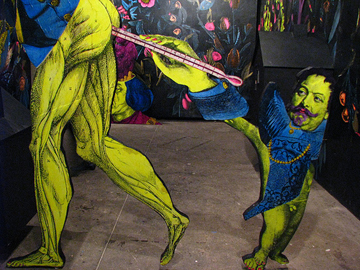
Dirt Mansion, an installation by Judith Supine at English Kills Gallery in Brooklyn, April, 2008. (Photo by C-M.)
In a move that undoubtedly goes against somebody’s better judgment, the respectable folks here at Art21 have asked me, C-Monster, puny art blogger and avid burrito eater, to do a few links round-ups (as I do on my own blog) in honor of this month’s Flash Points series: “What’s so shocking about contemporary art?“For the purpose of my first assignment, I thought I might take things literally. I’ve spent the better part of an afternoon trolling online museum collections for the word “shock”—either in the title or the describing text. This is hardly a scientific way to produce a list (a lot of museums don’t have searchable databases of their collections online). But it’s deliriously random (kinda like the web), and a good way of discovering how various artists have treated the idea of shock without being all self-conscious about it.
It’s also a good way of avoiding all the obvious names. (Because, really, how many times in one lifetime should a girl have to look at Piss Christ?) But it means that most of the links do not connect to images by contemporary artists. Not that this really matters. If there’s one thing I’ve learned in this exercise, it’s that shock in art is hardly anything new.
The shock of sex:
- Man Ray’s seriously booty-licious La Priére (Prayer), from 1930, at the Getty.
- More booty: Edo-era edition. Kitagawa Utamaro’s Utamakura (Poem of the Pillow), at the British Museum.
- Not quite sex, but close: Eugène Atget’s Three Prostitutes, rue Asselin, also at the Getty, in a style that Berenice Abbott described as the “shock of realism.” Perhaps what’s truly shocking is the smirky grins on these ladies’ faces, who all look like they could be my aunts.
- Plus: The thrill of unexpected nudity. John Lessore’s Diana and Acteon at the Byam Shaw, 1987, at the Tate, an homage to Titian’s Diana and Acteon.
The shock of color:
- “It shocks you every time.” William Eggleston, on his hyper-saturated (and ironically titled) blood-red photograph, Greenwood, Mississippi, at the Getty.
The shock of violence:
- Otto Dix’s 1924 etching Shock Troops Advance Under Gas, at MoMA.
- The shock of seeing your imminent death: a 19th century print by Tsukioka Yoshitoshi, at LACMA.
- Beautifully abstract until you discover the subject of the photo: Gun: Shock Wave and Discharge, 1960, by Harold Edgerton at the Met. See another more pointed image, from 1957, here.
- Sometimes shock is disaster. See Philip Evergood’s 1940 painting Railroad Bridge Collapse, at the Boston MFA.
- This one had me at the title alone: A representation of the horrid barbarities practised upon the nuns by the fish-women, on breaking into the nunneries in France, a 1792 etching I found on the British Museum’s website. Shocking, in a saucy 18th-century kinda way.
The shock of a prank:
- Waaaay before Banksy: L.H.O.O.Q., Marcel Duchamp’s vandalized Mona Lisa replica from 1919, at D.C.’s National Gallery.
The shock of shock:
- Looking shocked: A Man’s Face, c. 18th century, by Sir Nathaniel Dance-Holland, at the Tate, and Clandestine Marriage, an 1819 etching by Henry Hoppner Meyer, at the British Museum, .
- More surprise than shock, but wryly funny nonetheless: A Man Who Suddenly Fell Over, 1952 by British painter Michael Andrews, at the Tate.
- The gestures of shock: William Blake’s early 19th-century watercolor Judas Betrays Him, at the Tate.
- At England’s National Gallery, Queen Charlotte, 1789, by Sir Thomas Lawrence, captures the monarch after “having recently undergone the shock of George III’s first attack of apparent insanity.” Quite incredible. You can see the wear on her face.
C-Monster is a Brooklyn writer and blogger who is shocked by very little.




Pingback: The Digest. 12.18.08. at C-MONSTER.net